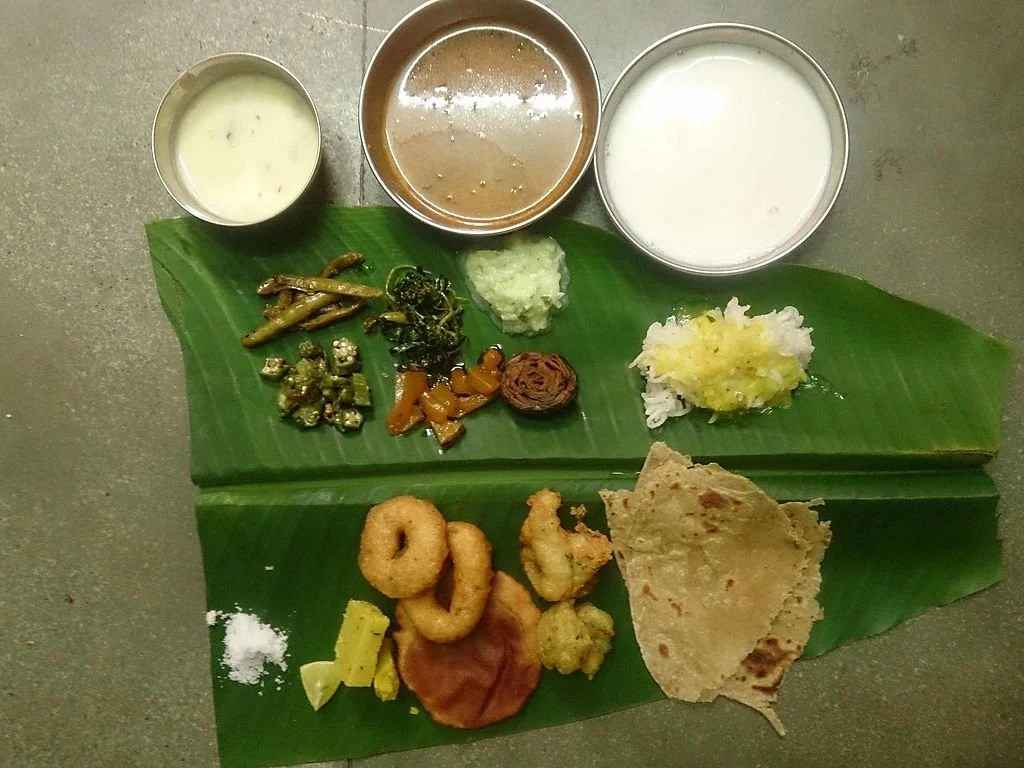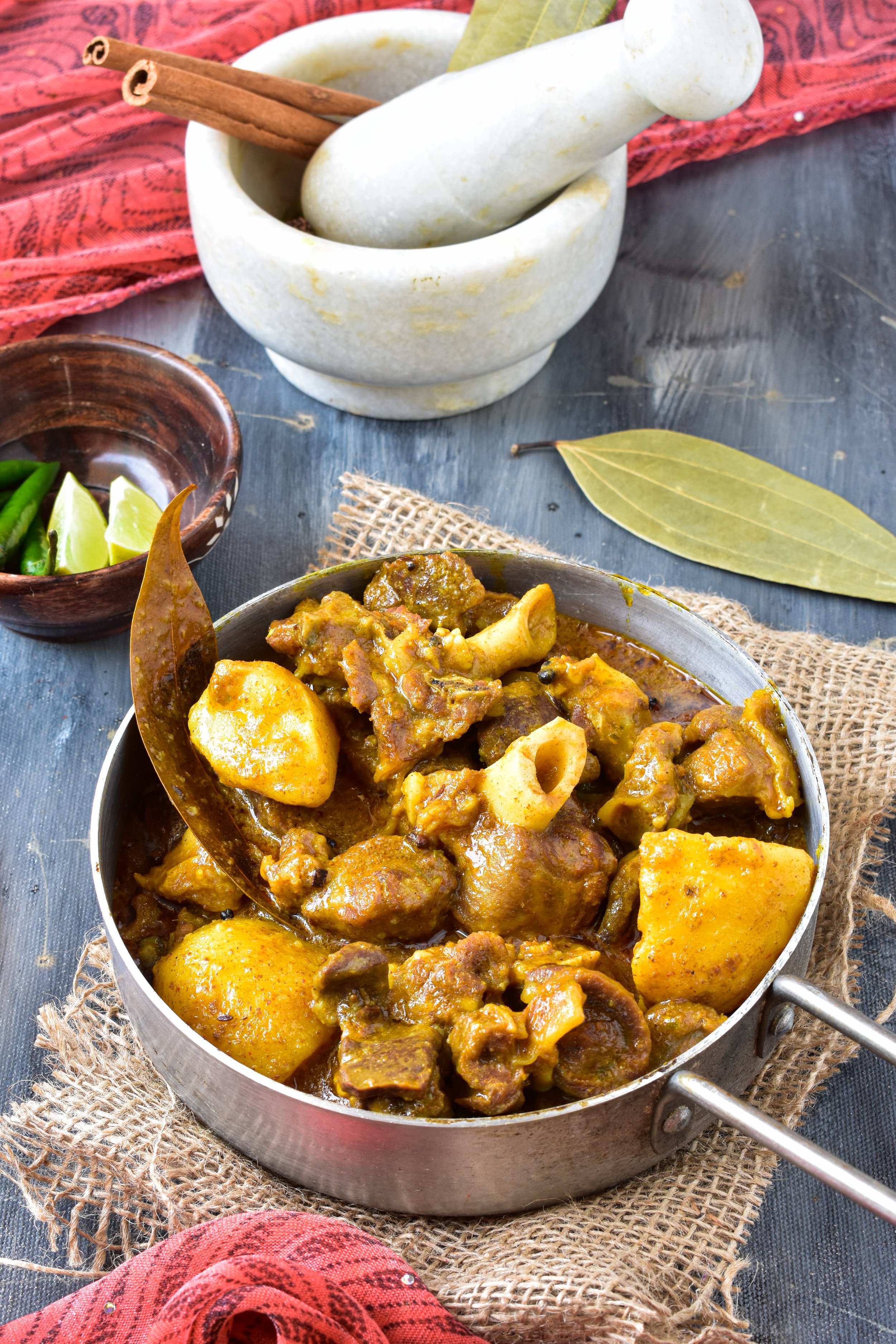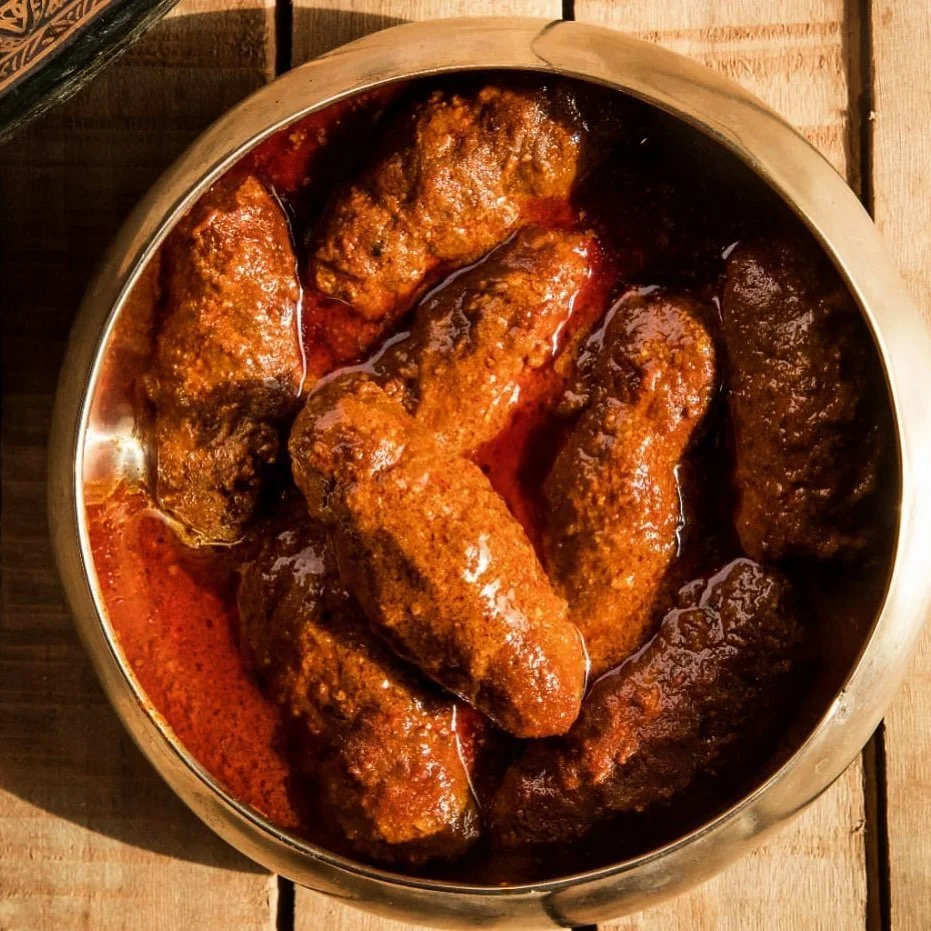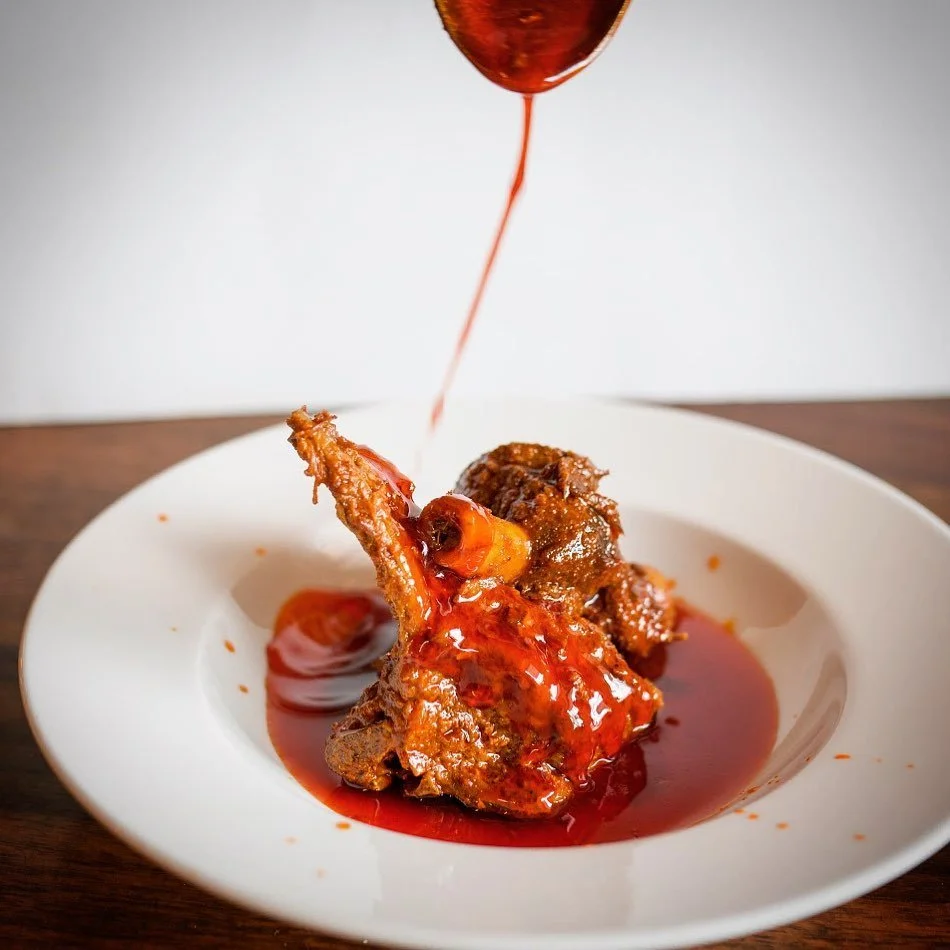Meaty Feasts for the Gods
Text by Rituparna Roy
Among the Kolis, a festive meal for goddess Gauri often features mutton curry served with deep-fried wade made of rice flour, locally called “ambavlele wade”. Photo courtesy: Siddharaj Thale
Sometime in the early ‘90s, the small neighbourhood where I grew up in Durgapur, an industrial township in West Bengal, decided to host its first Saraswati Puja. On a fine spring morning, the community gathered to celebrate the Hindu goddess of learning by erecting a makeshift temple, installing a clay idol, and hiring a Hindu Brahmin cook to prepare the bhog or sacred feast.
A menu of khichuri (one-pot rice and lentils), labra (spiced seasonal vegetables), bhaaja (vegetable fritters), tomato chutney (a sweet relish of tomatoes and dates) and payesh (rice and milk pudding)was unanimously agreed upon. This vegetarian spread is sacrosanct to every Hindu religious festival in this part of India.
Traditionally, a naivedya or sacred meal is often vegetarian. However, there are several exceptions to be found in regional Indian cuisines.
However, my mother had other plans. She insisted we visit her family instead for bhog. That lure was enough. My aunt was cooking ilish paturi — steaks of steamed hilsa or Indian herring coated in a silken mustard sauce, and encased in banana leaf parcels.
“It’s the goddess’ favourite fish,” she told me.
In the land of a million gods, where food is a powerful form of appeasement, many would consider my aunt’s offering audacious, even sacrilegious. In most Hindu communities, festivals are marked by foods prepared under a strict religious code.
These codes can vary. Some festive foods may proscribe garlic and onions; some may be prepared only after a ritual bath, while some communities may insist on cooks of a certain caste to stir the pots. But the most common standard seems to be to prohibit meat and fish from religious events.
This conforms to the widespread myth of India being a vegetarian nation, where vegetarianism is often considered a vestige of purity. Every town and city in the country has a slew of “pure veg restaurants,” and temple towns across India have banned the sale and consumption of meat anywhere near shrines. In a country where 80% of the population eats fish, eggs, chicken and meat, how do we determine what the gods prefer?
***
Offerings of fish and meat have been associated with prayer rituals for thousands of years. The Vedas, believed to have been composed around 1500 BCE, conform to this practice. In his formative work A Historical Dictionary of Indian Food, food historian K.T. Achaya noted that the Vedas “permit” ritual killings of cows, sheep, goats and horses. The sacred texts list about 250 animals, out of which 50 were considered appropriate for yajna or sacrifice. As so-called custodians of purity, the Brahmins — the priestly upper-caste — were entitled to the same meat.
The idea of equating vegetarianism with purity seems to be relatively recent. Around the seventh century BCE, new religious movements like Jainism, and later Buddhism, pushed back against violence to other species. Hindu Brahmins also transitioned to vegetarianism, and relegated meat-eaters to a lower social status.
This Brahmanical supremacy allowed them to offer cooked food to others, which further helped to position themselves as official cooks at religious ceremonies. These foods were considered “pakka,” and were typically prepared with ghee or clarified butter, an expensive choice of fat reserved for cooking feasts for the gods or for guests of high status.
***
Niramish mangsho, or mutton cooked without onions or garlic, is a part of the bhog offered on the ninth day of Durga Puja. Photo courtesy: Deepsikha Chakraborty
Animal sacrifice is a shared religious practice in India. The Hindu shakta tradition in the east as well as other parts of the country, endorses the oblation of blood through boli or animal sacrifice. As disciples of Shakti, shaktas believe in the supreme goddess, mother of all creation. Shakti, which literally translates to “power,” sees her incarnate as goddesses Durga, Gauri, Parvati or Kali, who are all manifestations of divine energy.
In Bengal, boli is a gift that is presented to the fierce goddess Kali, who slays cosmic demons, and later devours their flesh and blood. In her exegetical study The Self-Animal and Divine Digestion: Goat Sacrifice to the Goddess Kali in Bengal (The Journal of Asian Studies, 1994), Suchitra Samanta details the philosophy of ritual killings at Kolkata’s iconic Kalighat temple.
She noted balidaan as an “offering of a gift,” specifically goat sacrifices, where a Brahmin priest performs the rites of sacralisation of the goat. The cooked meat is part of a daily ritual spread which is placed at the altar, and includes fish in addition to an assortment of vegetarian items.
“On her part, Kali ‘consumes’ the offering by means of her eyes: ‘she looks upon it,’” she wrote.
The discourse around cooked meat is rather compelling. Niramish mangsho, which translates to “vegetarian meat” in Bengali, is a sanctified dish prepared sans onion and garlic.
“My speculation is that it displays the reaction of the devout Hindus to the cooking methods of the Muslims,” Bengali-American food historian and author Chitrita Banerji told me via email.
“Ingredients like onion and garlic were almost totemically associated with the latter. Since sacrificial meat was considered sacred, many purists believed if the meat was cooked without them, it maintained the sacrality.”
At the Kalighat temple, where niramish mangsho is cooked as part of a sacred feast, onion is substituted with hing or asafoetida. According to Banerji, the recipe may also have been based on the popular belief that the alliums heightened the libido, and are therefore sacrilegious. Niramish mangsho is also part of goddess Durga’s bhog on nabami, the ninth day of the Bengali autumn festival Durga Puja.
***
In Alibaug, a coastal town in the western state of Maharashtra, the seafaring Agri-Koli community observes a unique ritual during Ganeshotsav—the grand, 10-day festival that announces the arrival of Lord Ganesha.
Devotees bring home clay statues to worship the elephant-headed god, who is revered as the remover of obstacles in the Hindu pantheon. The Agri-Kolis believe Ganesha, fondly called Ganpati, to be their baby nephew.
Therefore, when his mother, goddess Gauri, arrives to join him, families get busy to pamper her with a naivedya or sacred meal. Being voracious fish and meat-eaters, the community cooks up a homecoming spread of chicken, mutton and seafood, primarily prawns, crabs and dried shrimp.
The goddess’ visit to her maternal home is considered special as she is believed to have journeyed through forests, rivers and mountains for days.
Siddharaj Thale, who has been documenting the folklore of his hometown in Alibaug, believes the food is symbolic of her tribal origins. He points out folk songs in the region that describe the goddess of being a “forest dweller” who travels from her abode in the holy Mount Kailash in the Himalayas to join her son Ganesha on earth. As the manifestation of Shakti, she is said to live on a diet of wild foods, which also includes meat.
***
Like the Bengali-Brahmins, consuming meat and fish is also ingrained in the sociocultural milieu of Kashmiri Brahmins, better known as Kashmiri Pandits. They belong to the larger Saraswat Brahmin community, which is believed to have settled along the banks of the ancient river Saraswati that once flowed through the region in and around modern-day Punjab and Rajasthan.
Being non-vegetarians could have been a survival strategy for the Kashmiri Pandits, as harsh winters and snowfall meant scarce vegetation. Nilamata Purana, an ancient text from the sixth century AD that documents the history, religion, culture and folklore of Hindu society in the Kashmir Valley, cites sacrificial feasts as part of worship.
In her translated work The Nilamata Purana — A Cultural and Literary Study, Sanskrit scholar Dr. Ved Kumari Ghai notes that meat and fish are customary to rituals in the Kashmiri Pandit community.
When a militant insurgency shook the Kashmir Valley in the early 1990s, the Pandits were forced to flee en masse and settle in other parts of the country. One of the few festive traditions that the community has maintained even in exile is Shivratri. Locally known as Herath, it celebrates the wedding of Lord Shiva and his divine consort Parvati. Ritual offerings of fish and lamb add fervour to the celebrations.
“Even the poorest of the poor save for a feast on Herath,” said Nalini Sadhu, who runs Matamaal, a restaurant that showcases the cuisine of Kashmiri Pandits in Delhi.
Sadhu remembers the elaborate feast her mother cooked on the day while she was growing up in Kashmir. The fish was typically Himalayan trout or carp, and sometimes gaad, a local species devoid of scales.
Masc or spongy meatballs are a highlight of Herath celebrations for the Kashmiri Pandit community. Photo courtesy: Matamaal
Meat was the highlight of the spread, and some of the dishes included rogan josh, a celebratory dish cooked with lamb in a carmine red, yoghurt-based gravy; khatta kaleji or tangy mutton liver, and spongy meatballs called masc. All of these were cooked without onions, garlic and tomatoes, along with a heady combination of khada masala or whole spices, asafoetida, fennel, and sonth or dried ginger, with underlying notes of red chilli powder.
The festivities were incomplete without shikaar or Indian game, which Sadhu’s father would be put in charge to secure from the local market. Shikaar nadur would be cooked into a fierce red curry with the beloved root vegetable nadur or lotus stem.
Herath always culminated in salaam the day after, when Muslim neighbors joined their Pandit friends in obeisance, and ate meat together. Today, many Pandits steer away from cooking non-vegetarian food on the day for fear of being shamed.
Roganjosh is also an important part of the Herath feast. Photo courtesy: Matamaal
“The mass exodus of the 1990s saw Pandits migrating to other parts of the country, to neighbourhoods that were strictly vegetarian,” said Sadhu. An increasing number of Kashmiri Pandits have also now turned to vegetarianism.
***
Rathina Sankari’s reflections of childhood are replete with memories of her ancestral home in Madurai, a temple town in Tamil Nadu. They also include memories of savouring the juiciest suvarotti or goat spleen, and tender mutton curries on the day of Lakshmi Puja.
The Pune-based freelance writer talks fondly about her grandmother, who would wake up at the crack of dawn to instruct her uncle about the preferred cuts and quantity of the goat meat to be bought from the butcher. This would be later cooked, and laid at the altar of the goddess of fortune.
Every year, the family travelled to the adjoining village of Lakshminarayanapuram to partake in a festival that involved goat sacrifices at the Kali Amman temple. The meat would be cooked in multiple ways — biryani, mutton fry and curry, and some portions dried to make uppukandam or dried meat cubes.
She told me that goat meat has been part of the local diet for centuries, and is readily available owing to an abundance of karuvelam or Prosopis juliflora trees in the region, which is the primary fodder for goats.
Achaya noted that meat consumption was widespread in south India before the arrival of the Aryans around the sixth century BC. He wrote about Kapilar, a Brahmin priest of the Sangam era, who consumed meat and liquor without much inhibition.
However, Madurai’s culinary heritage is in stark contrast to most temple towns in south India, where meat is forbidden, and food is cooked to the strictest standards of vegetarianism. Under the reign of the Pandya dynasty that is said to have ruled as early as the fourth century BCE, the town established itself as a bustling centre of trade, strengthening relations with the Greeks and the Romans.
Over time, the confluence of cultures shaped the local cuisine. Today, most mentions of Madurai also include a reference to the rare non-vegetarian feasts it has to offer.
According to cookbook author Meenakshi Meyyappan, ritual sacrifice is widespread across many temples in the region. The charismatic matriarch, who helms the century-old heritage hotel The Bangala in Karaikudi, belongs to the industrious Chettiar community.
As maritime tradesmen, the Chettiars travelled the world, and brought back new flavours to create their own complex cuisine, which features dishes such as fiery mutton fries, prawn curries and pepper chicken.
“Some sacrifices are for fulfilling vows, while a few are yearly rituals or associated with Shakti worship in Karnataka, Andhra Pradesh, Kerala and Tamil Nadu,” Meyyappan said.
Places of worship in and around Madurai organise goat, cock and hen sacrifices to please the guardian deity for better crop and health, and even for coming of age ceremonies. The meat is typically distributed to the families and relatives who partake in the sacrifices.
***
For Dalits, the topic of ritual foods bears the taint of oppression. Dalit cuisine is marginalised even in contemporary India, and for many Dalits, their memories of food are laced with pain. (For in-depth information on this subject, listen to Where There Are No Butchers, There Are Cinnamon Buns, Ep. 5 of Bad Table Manners, produced by the Whetstone Radio Collective). I spoke to veteran Dalit activist Dr. Kumud Pawde, who offered a reluctant glimpse into the ritual food practices of the Mahars, who are part of the larger Dalit community and live in the Vidarbha region of Maharashtra.
As the first Ambedkarite Sanskrit scholar, Pawde fought for the rights of Dalit women in the 1990s.
“I am a Buddhist now, and have turned vegetarian, so all this is a thing of the past,” said Pawde, 84, over the phone.
But she remembered the delicious naivedyams from her childhood, typically offered to Mahakali, the goddess of universal power. Pawde mentioned mundi (head), khur (trotters), rakti (blood), and entrails of the goat that were routinely cooked at religious events by the women in her family.
“Humko jo acha lagta tha, woh hum apne bhagwan ko dete the (we gave our gods what we liked to eat),” she said.
***
In his contentious work The Myth of the Holy Cow, eminent historian and author D.N. Jha wrote that “animals are verily food.” He reiterated his point by citing Vedic texts “that the animals sacrificed to gods represented ‘all food.’” Jha’s disquisition examined why high-rung Brahmins shunned animal sacrifice and adopted vegetarianism as a means to fuel their ambition in the battle for caste supremacy.
“The idea of vegetarianism in post Vedic India is a complex phenomenon, where being a vegetarian is considered morally superior,” said Mumbai-based archaeologist and culinary anthropologist Dr. Kurush F. Dalal.
The power dynamic of caste, and being on top of the social ladder allows one to sanction what others should eat, he added.
“It is important to understand that ritual foods are influenced by the eating habits and seasonal produce of a region. For instance, it is difficult to be a vegetarian in Bengal, where fish is abundantly available, and offered to propitiate the gods.”
Some of these customs reflect the cultural diversity of Indian society. The nine-day Navratri festival in western India is marked by fasting in honour of goddess Durga. In another corner of the country, in Bengal, the same goddess is treated to a feast of meat and fish. At the Muniyandi Swami temple in Tamil Nadu, an 85-year-old practice permits devotees to offer mutton biryani to its village deity. And in Assam, Hindu priests partake in the slaughter of goats and buffaloes at Guwahati’s ancient Kamakhya Temple. For thousands of years, communities across India have been proudly plating up a feast of meat for their gods.
And yet, the dominant narrative perpetuates the myth that India is predominantly vegetarian. This narrative has had serious repercussions. Parts of the country are placing restrictions on where and when meat can be sold. Midday meals in schools — a key weapon in the battle against malnutrition — are being altered because some leaders claim that eggs and meat are not Indian culture, and consuming them could turn children towards cannibalism.
At a time when food fascism is more real than ever, it may help to remember: what humankind eats, the gods also eat.





